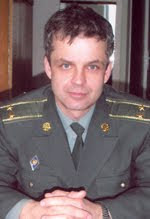Wednesday, October 17, 2012
The Ukrainian navy are training killer-dolphins to attack enemy combat swimmers by using special knives and pistols which will be fixed to their heads.
Posted by Oleg Bezverkhnii at 08:13 0 comments
Monday, October 8, 2012
Facing the Climate Continues Its Tour in Ukraine
Posted by Oleg Bezverkhnii at 17:46 0 comments
Wednesday, October 3, 2012
The touch on the history of Sweden in the depth of Saxony
Posted by Oleg Bezverkhnii at 22:22 0 comments
Labels: Augustus II the Strong, Charles XII, Great Northern war, Holy Roman Empire, Leipzig, Markranstädt, Peter I, Poland, Russia, Saxony, Stora Nordiska Kriget, Sweden, treaty of Altranstädt
Saturday, September 29, 2012
A new exhibition on the history of Poltava
Mostly all shown pictures of Poltava were found by chance in private photo albums of the local elderly residents. Many of pictures that were taken decades ago were shown to the public for the first time. For instance, many have never seen pictures showing German POW working as construction workers in
Being a teacher in charge of a student group, I invited then to visit this exhibition. Hope they have learnt a lot of a new fascinating things about the history of
Posted by Oleg Bezverkhnii at 15:16 0 comments
Friday, September 21, 2012
A joint parade of Soviet and German troops in Brest-Litovsk on September 22, 1939
The secret protocol of the Molotov–Ribbentrop Pact, signed on August 23, 1939 defined the boundary between the German and Soviet "spheres of influence". However, during their invasion of Poland, some German forces, especially Heinz Guderian's XIX. motorized Corps, have advanced beyond this line in pursuit of their strategic goals. The XIX. Corps, approached Brest on September, 13 and defeated the Polish resistance in the ensuing battle by September, 17, establishing their base of operations in the city. During the following days, Guderian was informed, much to his chagrin, that the demarcation line between German and Soviet-controlled regions was drawn along the Bug River and that his forces were to retreat behind this line by September, 22. On September, 17, after Vasily Chuikov's 4th Army received the order to cross the Polish border, its 29th Tank Brigade, led by Kombrig Semyon Krivoshein, entered the town of Baranovichi (pl. Baranowicze). After taking the town and capturing a few thousand Polish soldiers who were stationed there, his units kept on moving westward, reaching the village of Pruzhany (pl. Prużana) on 19 September.On 20 September, advance units of the 29. Tank Brigade, encountered Guderian's forces at the village of Vidomlya (pl. Widomla), three days after the Soviet invasion of Poland and twenty days after the German invasion of Poland.
During the meeting, Guderian proposed a joint parade of Soviet and German troops through the town, including a lineup of soldiers from both armies on the central square. Because the Soviet troops were tired after a long march, Krivoshein declined, but promised to supply a military band and a few battalions, and agreed to Guderian's request that he and Guderian would stand and review the parade together. According to the initial agreement, the procedure included German and Soviet troops marching before their commanding officers followed by changing the flag, accompanied by national anthems of Germany and the USSR. However, the Soviet commanding officer, Kombrig Semyon Krivoshein, writes in his memoirs that he did not allow Soviet troops to pass alongside the German forces, because he was afraid that Soviet troops, weary after a long march to Brest, would look inferior in comparison with the Germans, who stayed in the city for several days. Instead, he suggested that the Soviet columns would enter the city separately and salute the leaving Germans whenever they meet. The parade began at 16:00, and the "Victory Arches" were erected which the Soviet troops decorated with swastikas and red stars, and through which German troops marched. The Soviets fielded the 4th Battalion of 29th Light Tank Brigade, which was the first unit of the Red Army to roll into the city. The Soviet and German generals paid homage to each other's armies and their respective victories over Polish forces.
Posted by Oleg Bezverkhnii at 23:36 0 comments
Thursday, September 6, 2012
Ukraine has officially confirmed its participation in the NATO-led Ocean Shield anti-piracy operation
Posted by Oleg Bezverkhnii at 08:14 0 comments
Monday, August 13, 2012
Posted by Oleg Bezverkhnii at 09:32 0 comments
Labels: Air Force, Aviation, President Putin, Russia, Russian Army, Zhukovsky















